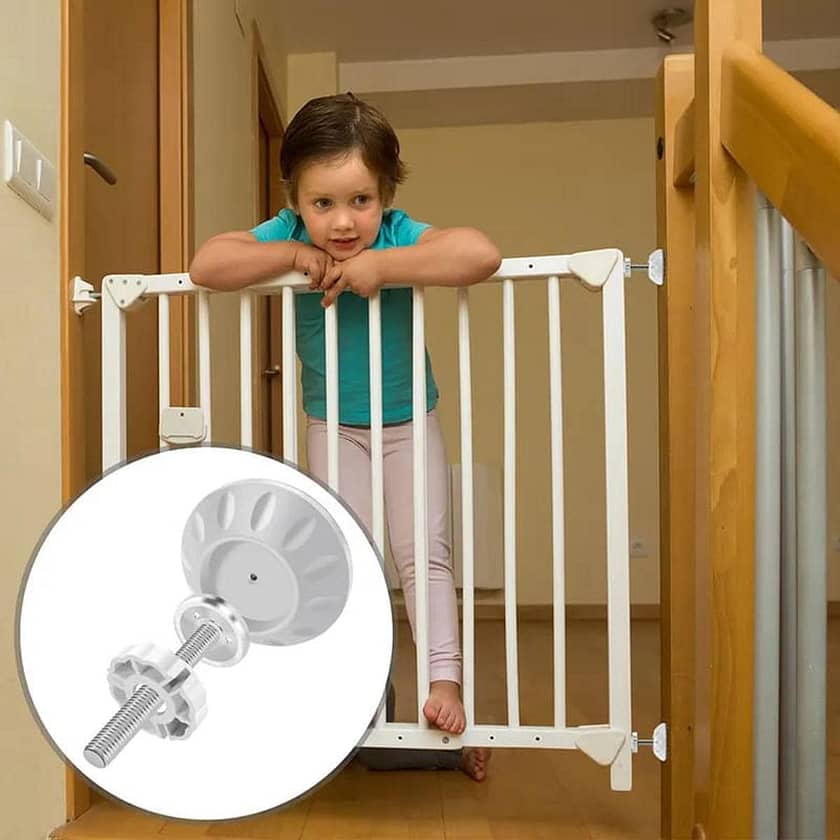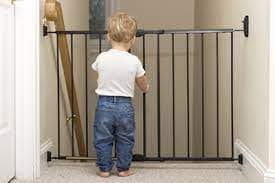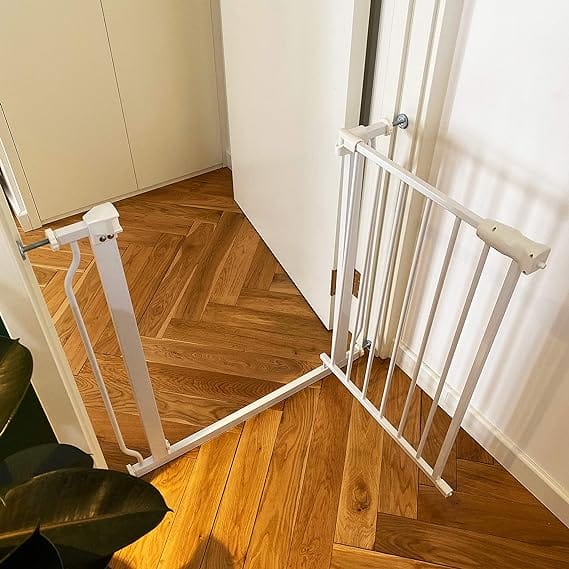Table of Contents
ToggleKnowing when to remove baby gates is a crucial milestone in the journey of parenting.
As your little one grows, develops, and begins exploring their surroundings with increased curiosity, baby gates serve as safety barriers.
However, determining the right time to take these gates down can often leave parents in a quandary.
This decision, while it may seem simple, can have significant implications for your child’s safety and independence.
When to Remove Baby Gates?
When it comes to removing baby gates, there’s no universal right or wrong time. However, a commonly suggested age is when the child is around two to three years old. This is typically when they can navigate stairs safely on their own.
It’s important to remember that every child develops differently, so use your judgment and knowledge of your child’s abilities and readiness when making this decision.
Learning When to Take Down Baby Gates

While the age of two to three years old is often suggested, it’s not a hard and fast rule. A more detailed guideline is when your child can safely and confidently navigate stairs without assistance.
This may involve watching your child climb and descend stairs while using the handrail.
Notice if they can balance without support and can alternate feet on each step.
Another sign that it may be time to remove baby gates is when your child begins to climb over them.
This can actually introduce a new risk of falling. If your child is attempting to climb the gate, they might be ready for the gate to be removed.
Lastly, consider your own comfort level and your household’s specific circumstances.
If there are particularly dangerous areas in your house that children cannot safely access without an adult, it may be best to keep the gates up longer.
In contrast, if your child is mature for their age and understands safety rules, you might feel comfortable removing the gates sooner.
Remember, this is more about your child’s capabilities than their age. Use your knowledge of your child and their development to make the best decision for your family.
Are Your Kids Responsible Enough for It?
Assessing your child’s responsibility is a key factor in deciding when to remove baby gates. A child’s understanding of safety rules, ability to follow instructions, and awareness of danger play into this. Here are some points to consider:
- Understanding and Respect for Rules: Does your child understand the safety rules you’ve set in your home and consistently follow them? This could include rules like not going into the kitchen when the stove is on or not playing near the staircase. Children who understand and respect these rules are showing a level of responsibility.
- Ability to Understand Danger: Can your child understand what a dangerous situation is? Do they recognize that climbing on a high table or running on a wet floor can lead to falls and injuries? If they show an understanding of potential dangers, it indicates they are becoming more responsible.
- Self-Control: Does your child demonstrate self-control? Can they refrain from doing something they’ve been told not to, even if you’re not in the same room? Self-control is a key marker of responsibility.
Overall, these points can help you evaluate your child’s responsibility level and readiness to navigate the house without baby gates. Remember, it’s not about reaching a certain age, but about reaching a certain level of maturity and understanding.

Identifying the Right Age and Maturity Level for Taking Down Baby Gates:
Age Group: 2-3 Years Old:
At this age, many children begin to demonstrate the physical coordination required to navigate stairs independently. They can usually balance well and alternate feet on each step. However, their understanding of safety rules might still be developing, so continue observing their behavior and enforcing household safety rules.
Age Group: 3-4 Years Old:
Children in this age group often have a more developed sense of danger. They can understand basic safety rules, and their physical coordination is usually well-developed for navigating stairs. However, they may still require supervision in potentially hazardous areas of the home, such as the kitchen or bathroom.
Age Group: 4-5 Years Old:
By this age, most kids can recognize dangerous situations and understand more complex safety rules. They show increased self-control and can be trusted to follow safety rules even when unsupervised. It’s generally safe to remove baby gates at this stage, provided you have confidence in your child’s ability to navigate your home safely. However, if there are high-risk areas in your house, you may want to keep some gates up for longer.
Remember, these are just guidelines. The decision should be based on your child’s individual maturity level and understanding of safety rules, not strictly their age.
Evaluate your child’s behavior and use your judgment to decide when it’s time to remove baby gates.
The transition to removing baby gates is an important milestone in a child’s growth, but it should happen only with careful consideration of their readiness level for navigating the house safely and responsibly.
With proper monitoring and guidance, you can ensure that this process goes smoothly.
What Are the Benefits of Removing Baby Gates and Keeping Your Home Safe for Kids to Explore?

Taking down baby gates and creating a safe home environment for your children to explore has numerous benefits.
- Promotes Independence: Removing baby gates allows your child to explore more areas of the home on their own. This freedom promotes independence and allows them to make choices and decisions, fostering growth and self-confidence.
- Encourages Problem-Solving Skills: Without gates blocking their path, children can encounter new situations and learn how to navigate them. This can encourage the development of problem-solving skills as they figure out how to handle different scenarios.
- Enhances Physical Development: Climbing stairs and exploring different levels of the house can help improve your child’s motor skills, coordination, and balance.
- Boosts Cognitive Development: Navigating a larger space can stimulate your child’s cognitive development. It involves remembering routes, understanding spatial relationships, and recognizing patterns.
- Fosters Responsibility: Teaching your child about safety in the absence of gates can foster responsibility. They learn to follow safety rules and understand the consequences of not adhering to them.
- Reduces Risks of Climbing Accidents: If your child has started to climb over the baby gates, removing them can actually reduce the risk of falls and climbing accidents.
Remember, removing baby gates should be accompanied by educating your child on home safety rules and constantly monitoring their activities until they prove their understanding and adherence to these rules.
For a comprehensive understanding of how baby gates can be strategically placed and used in different parts of your house for optimum safety, I highly recommend checking out this informative article on How to Use Baby Gates in a House.
Setting Up Rules and Regulations for Taking Down Baby Gates:
Rule 1: Establish Clear Safety Guidelines
Before removing baby gates, it’s crucial to establish clear safety guidelines for your child. Explain to them the dangers present in certain areas of the house, and why it’s important not to enter these zones without an adult. Make sure they understand rules such as not touching electrical appliances or climbing on furniture. Practicing these rules with your child until they feel comfortable and you feel confident in their understanding is a great way to prepare for the removal of baby gates.
Rule 2: Keep Hazardous Materials Out of Reach
Even if your child understands the safety rules, it’s essential to keep hazardous materials out of reach. This includes cleaning supplies, sharp objects, small choking hazards, and any other potentially dangerous items. It’s best practice to keep these items in locked cabinets or high shelves that your child can’t access.
Rule 3: Supervise Initial Exploration
After taking down the baby gates, supervise your child’s initial exploration of the newly accessible areas. This allows you to observe how they handle new situations and correct any dangerous behavior immediately. It also gives your child the confidence to explore knowing you’re there to help if needed.
Rule 4: Regularly Reiterate Safety Rules
Even after the child has shown understanding and adherence to the rules, it’s important to regularly reiterate the safety guidelines. This helps reinforce the behavior and ensures that they don’t forget or become lax about following the rules. You can make this process fun and engaging by turning it into a game or quiz.
Remember, the safety of your child is paramount. Allowing them to explore without baby gates should only be done when you’re confident in their understanding of safety rules and their ability to adhere to them.
Introducing New Challenges to Your Home When the Baby Gates Are Removed:
Once the baby gates are removed, it’s important to introduce new challenges for your child. This can help them refine their problem-solving skills and become confident in navigating more complex situations.
- Set Up an Obstacle Course: Set up a fun obstacle course in a designated area of the house. This can involve maneuvering around furniture, climbing stairs, or navigating a maze of toy blocks. This encourages your child to use their physical and cognitive skills to complete the course.
- Provide Open-Ended Toys: Provide open-ended toys that can be used in different ways, such as building blocks or a set of action figures. These provide endless possibilities for creativity and problem-solving, allowing your child to explore different scenarios and challenges.
- Have Family Game Nights: Having regular family game nights can encourage your child to think strategically and develop better problem-solving skills. Games like chess, Connect 4, or Mastermind can help them hone their decision-making capabilities while having fun with the family.
- Involve Your Child in Non-Game Activities: Involving your child in activities like cooking, gardening, or home maintenance can help them understand the importance of safety and responsibility. These tasks also require problem-solving skills, allowing your child to use their creativity and come up with new solutions.
By introducing new challenges as the baby gates are removed, you can help encourage your child’s cognitive and physical development while keeping
Tips on How To Make The Transition Easier for Everyone in The House:
- Communicate as a Family: Discuss the upcoming changes as a family, explaining to your child why the baby gates are being removed and what new challenges they can expect.
- Consistent Reinforcement: Reinforce safety rules consistently and reward your child for following them. This encourages adherence and makes the transition easier.
- Gradual Process: Do not remove all the gates at once. Start with one gate and see how your child responds, then progressively remove more gates.
- Safe Exploration Time: Allow for periods of “safe exploration” where your child can explore the newly accessible areas under close supervision.
- Keep Open Communication: Encourage your child to share their feelings about the removal of gates and discuss any fears or concerns they might have.
- Patience: This transition might be frustrating and scary for your child. Be patient and understanding, providing comfort and reassurance whenever needed.
- Involve Your Child: Make your child a part of the process. They can help take down the gates and be involved in rearranging the home. This can make them feel more confident and secure about the changes.
- Maintain Regular Routines: Try to maintain regular routines to provide some stability during this transition period. This can help make the changes feel less overwhelming for your child.
- Flexibility: Be flexible and be prepared to adjust your plans based on your child’s reactions and comfort levels. Sometimes, you might need to re-install gates temporarily until your child is more comfortable.
- Reinstate Gates When Necessary: If you notice that your child is not ready or if there are safety concerns, do not hesitate to put the gates back up. The priority is the safety of your child, not adhering to a predetermined timeline.

When Should You Re-Install Baby Gates and Other Safety Equipment in Your Home?
Reinstalling baby gates and other safety equipment should be considered if there are significant changes in your home environment that pose a new risk, such as a renovation project or the addition of new furniture.
Additionally, if there is a noticeable regression in your child’s adherence to safety rules or their ability to navigate the home safely, it may be wise to reintroduce the gates until their confidence and understanding improve.
If a new sibling or pet joins the family, you may also need to reinstall the gates, as they may not have the same understanding of safety rules. Always remember, the primary goal is the safety of your child; any steps necessary to ensure this should be taken, including reinstalling gates or other safety equipment, as required.
Determining when to remove baby gates is a significant aspect of ensuring your child’s safety. It’s essential to maintain a balance between protecting your child and allowing them to explore their surroundings for their development. More information on balancing baby safety can be found here.
Conclusion:
In conclusion, the decision to remove baby gates in your home is multifaceted and should be approached with caution. It’s important to prepare your child for this transition by reinforcing safety rules, gradually introducing new challenges, and ensuring open communication.
Equally critical is the readiness to reinstall safety equipment if necessary, to adapt to new circumstances or address any safety concerns that may arise. The safety and well-being of your child are paramount, and this should guide all decisions associated with the removal of baby gates.


2 thoughts on “When to Remove Baby Gates?”